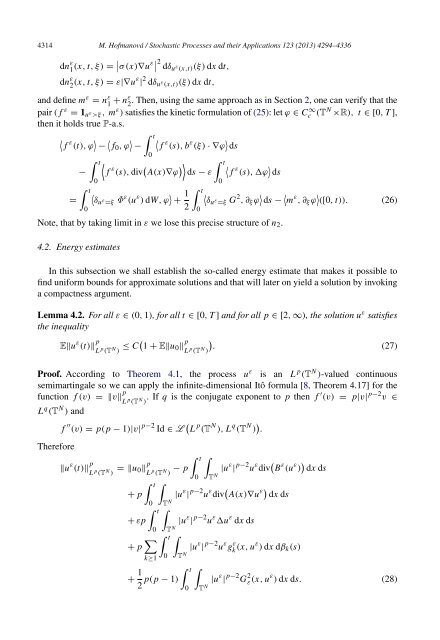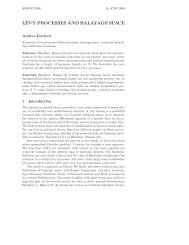Degenerate parabolic stochastic partial differential equations
Degenerate parabolic stochastic partial differential equations
Degenerate parabolic stochastic partial differential equations
Create successful ePaper yourself
Turn your PDF publications into a flip-book with our unique Google optimized e-Paper software.
4314 M. Hofmanová / Stochastic Processes and their Applications 123 (2013) 4294–4336<br />
dn ε 1 (x, t, ξ) = σ (x)∇u<br />
ε 2 dδ u ε (x,t)(ξ) dx dt,<br />
dn ε 2 (x, t, ξ) = ε|∇uε | 2 dδ u ε (x,t)(ξ) dx dt,<br />
and define m ε = n ε 1 + nε 2<br />
. Then, using the same approach as in Section 2, one can verify that the<br />
pair ( f ε = 1 u ε >ξ , m ε ) satisfies the kinetic formulation of (25): let ϕ ∈ Cc ∞(TN ×R), t ∈ [0, T ],<br />
then it holds true P-a.s.<br />
<br />
f ε (t), ϕ − f 0 , ϕ t <br />
− f ε (s), b ε (ξ) · ∇ϕ ds<br />
=<br />
−<br />
t<br />
0<br />
t<br />
0<br />
0<br />
<br />
f ε (s), div A(x)∇ϕ ds − ε<br />
<br />
δu ε =ξ Φ ε (u ε ) dW, ϕ + 1 2<br />
t<br />
0<br />
t<br />
0<br />
<br />
f ε (s), ϕ ds<br />
Note, that by taking limit in ε we lose this precise structure of n 2 .<br />
4.2. Energy estimates<br />
<br />
δu ε =ξ G 2 , ∂ ξ ϕ ds − m ε , ∂ ξ ϕ ([0, t)). (26)<br />
In this subsection we shall establish the so-called energy estimate that makes it possible to<br />
find uniform bounds for approximate solutions and that will later on yield a solution by invoking<br />
a compactness argument.<br />
Lemma 4.2. For all ε ∈ (0, 1), for all t ∈ [0, T ] and for all p ∈ [2, ∞), the solution u ε satisfies<br />
the inequality<br />
E∥u ε (t)∥ p L p (T N ) ≤ C 1 + E∥u 0 ∥ p L p (T N )<br />
. (27)<br />
Proof. According to Theorem 4.1, the process u ε is an L p (T N )-valued continuous<br />
semimartingale so we can apply the infinite-dimensional Itô formula [8, Theorem 4.17] for the<br />
function f (v) = ∥v∥ p L p (T N ) . If q is the conjugate exponent to p then f ′ (v) = p|v| p−2 v ∈<br />
L q (T N ) and<br />
f ′′ (v) = p(p − 1)|v| p−2 Id ∈ L L p (T N ), L q (T N ) .<br />
Therefore<br />
t <br />
∥u ε (t)∥ p L p (T N ) = ∥u 0∥ p L p (T N ) − p<br />
|u ε | p−2 u ε div B ε (u ε ) dx ds<br />
0 T<br />
N t <br />
+ p |u ε | p−2 u ε div A(x)∇u ε dx ds<br />
0 T<br />
N t <br />
+ εp |u ε | p−2 u ε u ε dx ds<br />
0 T N<br />
+ p t <br />
|u ε | p−2 u ε g ε<br />
k≥1 0 T N k (x, uε ) dx dβ k (s)<br />
+ 1 t <br />
2 p(p − 1)<br />
0<br />
T N |u ε | p−2 G 2 ε (x, uε ) dx ds. (28)



